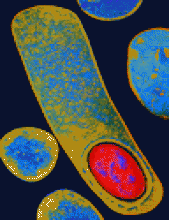Protein punch: Researchers with the Ottawa Health Research Institute (OHRI) have identified a key gene responsible for regenerating damaged muscle tissue. CEO Ron Worton hailed the discovery as a major step toward developing methods of reversing the debilitating effects of muscle-wasting disease. “It's an extremely important development in the ongoing saga of trying to treat children and adults with various forms of muscular dystrophy,” he said. The gene Pax7 is one of 9 related to muscle repair. But the work of a team led by OHRI Senior Scientist Michael Rudnicki revealed that this particular protein can by itself initiate the process of turning adult stem cells into muscle cells. Rudnicki is to head the Centre for Stem Cell and Gene Therapy that is expected to open later this year at the Ottawa Hospital's General Campus. The findings were published in the May issue of the Public Library of Science Biology, an open-access journal (www.plosbiology.org). — Tim Lougheed, Ottawa

Figure. Photo by: Comstock

Figure. Photo by: Art Explosion
When alerts fail: The safety features of computing systems used by about three-quarters of UK general practices have clinically significant deficiencies, including failure to detect prescribing errors when a warning is expected. The recent study (BMJ 2004; 3238: 1171-2) reveals that more than 90% of GPs in the UK regularly use computers for clinical care. These systems are regulated by the National Health Service and must contain drug interaction alerts. However, relatively little attention has been paid to other potential safety features for prescribing, including contraindication alerts. The researchers tested 18 scenarios on 4 computer systems using dummy patient records. None of the systems produced alerts for any scenarios. For example, there was no warning about drugs with similar names, oral contraceptive pills were prescribed to women with a history of deep-vein thrombosis and children were prescribed acetylsalicylic acid (aspirin). One solution, conclude the researchers, would be more explicit regulations as to when suppliers should implement specific alerts. “Because information technology, pharmacology and medicine are dynamic fields, suppliers of systems and drug databases would need to have regular dialogue with end users about ways of further improving the safety features of these important aids to clinical management,” the document states. — Pauline Comeau, Ottawa
AIDS money: AIDS organizations had a guarded response to the federal government's announcement that funding for the Canadian AIDS Strategy will double over the next 5 years. Funding for the strategy had been frozen for 11 years at $42.2 million a year, and the federal Standing Committee on Health last year recommended it immediately increase to $100 million. Instead, an extra $42.2 million will be phased in over 5 years, with $5 million added the first year, $8 million each of the next 3 years and $13.2 million in the final year. The government has “at last given more than lip-service to fighting Canada's costly HIV epidemic,” said Louise Binder, spokesperson for the Canadian Coalition for HIV/AIDS Stakeholder Organizations, which includes groups such as the Canadian AIDS Society. But the increase “will result in most of the new money arriving at the frontlines too late for use to stop the next wave of infections and treatment failures that's about to crash down on Canada,“ she said. — Ann Silversides, Toronto
Fetal alcohol syndrome warning: Ontario may be the first Canadian jurisdiction to require warning signs at liquor outlets. A private members bill informally known as “Sandy's Law” would require all establishments selling liquor to post a sign warning of the risks drinking poses to a fetus. It is expected to be law by June 30. Liberal MPP Ernie Parsons introduced the bill after his adopted son Sandy died suddenly last year at age 25 from a brain aneurysm due to heart and circulatory problems caused, doctors believe, by fetal alcohol syndrome. The bill garnered unusual unanimous approval in principle when it was introduced for second reading in April. FAS is estimated to affect 9 out of every 1000 children born in Canada. Nineteen US states have similar regulations.— Pauline Comeau, Ottawa
Bionic boy: Nine-year-old cancer patient Nicholas McConnell-Kinney is the first Canadian to be fitted with the Repiphysis implant, a spring-loaded, titanium and plastic rod in his upper arm that will grow as he grows. “It's really, really cool,” says Nicholas, back home in Woodstock after the ground-breaking surgery at the Queen Elizabeth II Health Sciences Centre in Halifax. The prothesis replaced 15.5 centimetres of cancerous bone in the boy's upper arm. Cherie McConnell, Nicholas' mother, said she had no qualms when orthopedic surgeon, Dr. Michal Gross, recommended the implant. “The alternatives were not acceptable,” she said of amputation or repeated surgeries. “He has been through enough.” The implant, developed by a French surgeon 6 years ago, will be expanded internally as Nicholas grows, using an electromagnetic coil. — Compiled by Barbara Sibbald, CMAJ











